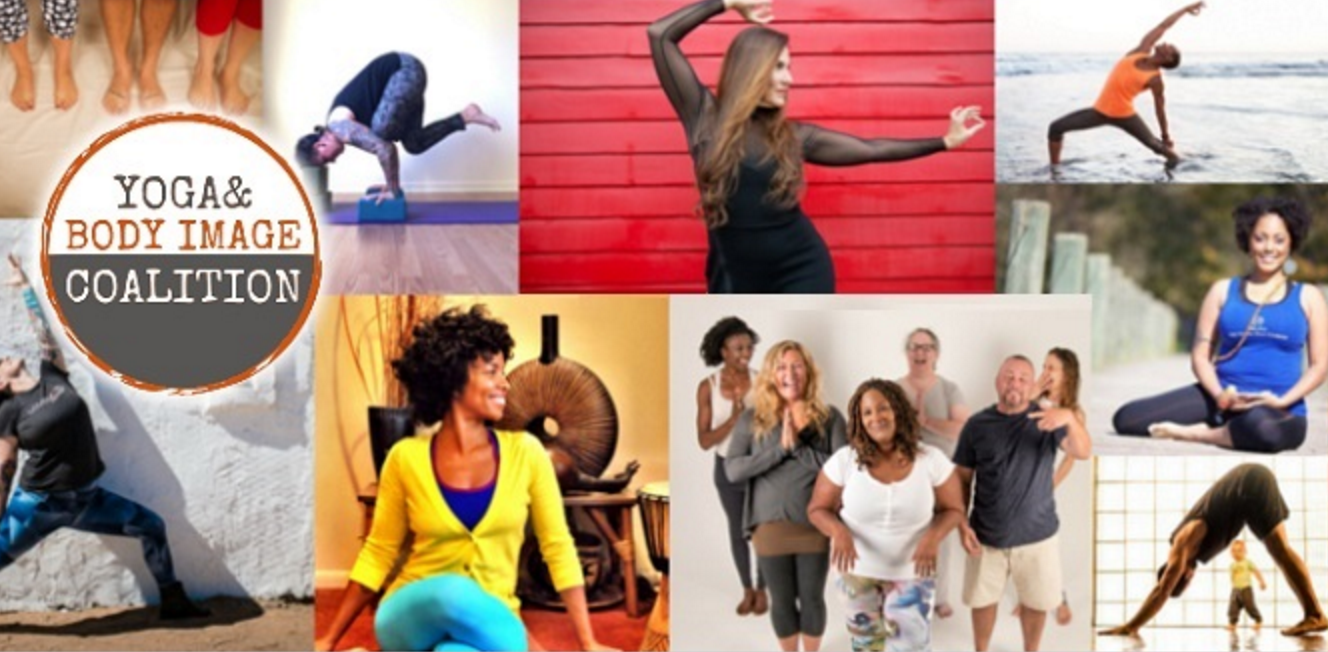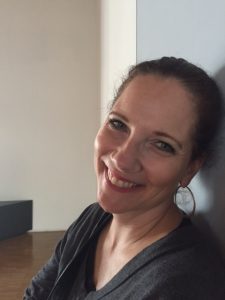Finding Home: A Yoga Teacher’s Story of Bilateral Hip Replacement
April 14, 2016
The following is a guest blog post by Gwen Soffer for the Yoga and Body Image Coalition.
 Here I am, about to go into surgery for a bi-lateral hip replacement. It’s funny how sometimes seemingly independent events align in your life. As I prepare for surgery and I grapple with the loss of movement, flexibility, and strength that I took for granted for so many years, I am also witnessing my parents sell their house and get rid of half of their possessions as they move into a smaller apartment. I had not made the connection until I found myself frustrated and saddened by my new limited range of motion, and I started worrying about my parents as they move into this new phase of life. I realized just as they were dealing with letting go of their house, their possessions, and all of the self-identifying connections they built there, I was also sitting with a big dose of surrender and letting go of my connection to a younger and more forgiving body that I once had. “Letting go” always sounds so great when you talk about it in the abstract as a philosophy, but the reality of this effort is super uncomfortable and can really suck.
Here I am, about to go into surgery for a bi-lateral hip replacement. It’s funny how sometimes seemingly independent events align in your life. As I prepare for surgery and I grapple with the loss of movement, flexibility, and strength that I took for granted for so many years, I am also witnessing my parents sell their house and get rid of half of their possessions as they move into a smaller apartment. I had not made the connection until I found myself frustrated and saddened by my new limited range of motion, and I started worrying about my parents as they move into this new phase of life. I realized just as they were dealing with letting go of their house, their possessions, and all of the self-identifying connections they built there, I was also sitting with a big dose of surrender and letting go of my connection to a younger and more forgiving body that I once had. “Letting go” always sounds so great when you talk about it in the abstract as a philosophy, but the reality of this effort is super uncomfortable and can really suck.
It is of no surprise to me that the reality and the metaphor of these experiences is a “home,” a theme that I have met often in my life. As my parents face letting go of the house that they have lived in for many years and the many possessions they have grown attached to, of course, it is the realization of moving to a new phase of life that is really the tricky part. As I deal with my body that has deteriorated arthritic joints and surrender to the fact that I need surgery, I have that same sense of standing in an empty house looking around as I assess what stays and what goes.
No matter how self-aware we are, we can fall into a false sense of permanency, and in our desperation to believe that the permanent is possible, we attach ourselves to things whether they are our house or our body. We collect things along the way that say, “I was here,” and it makes us feel connected and stable as we look around at the reminders of our relationships, our experiences and our accomplishments. We think the house is holding the memories, but in reality it is the intangible concept of home that has the real proof of our existence.
It has been a strange journey to get here with a serious test to my yoga practice—both physically and emotionally, especially when the physical practice is so painful that I have to pack it up for awhile. Although I have committed to being super kind to my body during this process, I would be lying if I said I have not come up against fear, anger, disillusionment, resentment, frustration and sadness. I have been practicing yoga for years, I am a yoga teacher, I eat well, and I have always been healthy. I knew yoga was not the cure-all that it is often portrayed to be, but I expected a little bit more from it than this. As I start to tell people what is going on, usually the first thing they say is, “even with all that yoga?” The fact is that yoga has nothing to do with it. This is a case of genetics and age, and as I sit in the rickety house that is my home, I am reluctantly letting go of what I think this house should look like or be able to do.
I have been moving through various phases of accepting this, and it has not been a smooth transition. I originally had a master plan to get this done secretly and only tell people after I had already recovered from the procedure with my new super hips in place. With a lot of reflection, I realized more than the fear of the procedure was the fear of appearing old or weak. The image of myself as a yoga teacher, just like a cherished old photograph, was taken off of the wall, wrapped in bubble wrap and tucked in a cardboard box to be sent out with the movers. How would I explain to people that I can’t move in the way I used to? That I can’t demonstrate poses effortlessly? That I can’t casually strike a pose on demand? I suddenly was at odds with my own body, and I could not push through this on my own. In my struggle, I remind myself of how grateful I am that there is something that I can do about the problem, but below the gratitude is a feeling of helplessness and insecurity.
As I watch my parents thoughtfully go through the items in their house that they will keep and the ones they will let go of, I make the connection that the house is not the home. As they pack up their cherished items to send off to someone else’s house or donate to a local library or organization, there is a combined sense of melancholy and relief. The past has so many memories, and each item has a story connected to it. Letting the item go can feel like you are letting the past go and maybe the many joys and self-identifying markers that are embedded into it until you realize that the memories and the home still remain regardless of the house that surrounds them. It is the home that is permanent not the house, and for all these years we have been attaching meaning to what we perceived as the permanent structure and the various objects inside. When I graduated college, my father said to me, “nobody can ever take that away from you.” I am realizing the same is true now, and maybe I need to repeat my dad’s words back to him. Nobody can ever take those memories of home away from you.
So what does this have to do with hip replacement? Suddenly it has everything to do with it. My body is my house but not my home. My home can withstand the test of time, weathering any storm, finding beauty in the moment and the peace in letting go. As a yoga teacher, I am frightened by what may lay ahead because I know the I am in some ways leaving the youthful house behind with all the things I thought were permanent fixtures in my life and identified me as a yogini. Although I respect the house that I am in, it does not define the essence of what my home is. So for now, as I get ready for surgery, I think I will snuggle up on the couch, pour myself a cup of tea, take a look around at the cleared out room and be in the comfort of my own home.
About Gwen:
Gwen Soffer is a trauma-informed yoga teacher, women’s self-defense instructor, author, and community mentor. She is co-founder of Enso studio in Media, Pa. and leads trauma-sensitive yoga classes for survivors of trauma. She believes in the strength of the human spirit and is committed to creating safe and empowering spaces for her students to heal. www.experienceenso.com

Please check Dr. Mercola’s website, mercola.com — I recently saw something about exposure to full-spectrum daylight having a significant salutary effect on osteoarthritis. Also you might need to get onto the new healthy diet based on recent research that finds that saturated fats are not the villain and that a high-fat (over 50%) (no trans fats, however) diet is healthier, though carbs and protein are needed in the right amounts, too, to avoid all the chronic conditions that are due to inflammatory responses to our high-sugar’high-grain American diet. Try Perfect Health Diet by Jaminet and Jaminet — very thorough and very well-thought-out and well researched. Also, for hip problems, I hope you haven’t gone for the surgery yet — please consult the Trigger Point Therapy Workbook by Davies and Davies, as they say most hip replacements are based on a presumption that the pain is coming from a deteriorated joint when in over 90% of cases the pain is muscular in nature and can be cured with long careful massage. It requires a change of life to put as much time into massaging yourself with a massage cane and tennis balls and high-bounce balls and foam rollers as you used to put into yoga, but I now devote time to the self-massage daily. I could share more. Try mercola.com for most of the latest. The health of your mitochondria may be critical for avoiding all these chronic conditions, and that seems to depend on avoiding sugar, avoiding eating for 3 or more hours before bed and perhaps doing intermittent fasting (about 16 hours without eating) a few times a week, and seeking more healthy sun exposure, including enough midday UVB sun to get your Vitamin D into the healthy range. Gee, I must sound like a health nut, but I now think all this stuff matters! But I ended up reading your lament because I had heard that veteran yoga instructors are going in for hip replacements at a high rate and it is thought to have something to do with the stress of certain yoga moves on the hip joints. One teacher I worked with had a revised workout that used belts to hold our hip joints together during certain poses.
What a courageous and insightful process prior to surgery. Truly inspirational. I totally resonates as I have just had a hip replacement last week following a fall. I have always been fit and active and have been grieving a bit this week but after reading this I will look for further meaning to guide my life
Also see this article from the New York Times about the epidemic of hip problems among yoga practitioners, particularly women:
http://www.nytimes.com/2013/11/03/sunday-review/womens-flexibility-is-a-liability-in-yoga.html
I smiled and teared up reading this….im going to be doing the same thing….meeting surgeon this week. I totally related to your words. X
I would like to hear how it went as I am preparing for a right hip replacement. Any advise?